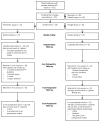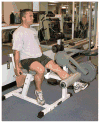Time line for noncopers to pass return-to-sports criteria after anterior cruciate ligament reconstruction
- PMID: 20195019
- PMCID: PMC3613129
- DOI: 10.2519/jospt.2010.3168
Time line for noncopers to pass return-to-sports criteria after anterior cruciate ligament reconstruction
Abstract
Study design: Randomized clinical trial.
Objectives: Determine effective interventions for improving readiness to return to sports postoperatively in patients with complete, unilateral, anterior cruciate ligament (ACL) rupture who do not compensate well after the injury (noncopers). Specifically, we compared the effects of 2 preoperative interventions on quadriceps strength and functional outcomes.
Background: The percentage of athletes who return to sports after ACL reconstruction varies considerably, possibly due to differential responses after acute ACL rupture and different management. Prognostic data for noncopers following ACL reconstruction is absent in the literature.
Methods: Forty noncopers were randomly assigned to receive either progressive quadriceps strength-training exercises (STR group) or perturbation training in conjunction with strength-training exercises (PERT group) for 10 preoperative rehabilitation sessions. Postoperative rehabilitation was similar between groups. Data on quadriceps strength indices [(involved limb/uninvolved limb force) x 100], 4 hop score indices, and 2 self-report questionnaires were collected preoperatively and 3, 6, and 12 months postoperatively. Mann-Whitney U tests were used to compare functional differences between the groups. Chi-square tests were used to compare frequencies of passing functional criteria and reasons for differences in performance between groups postoperatively.
Results: Functional outcomes were not different between groups, except a greater number of patients in the PERT group achieved global rating scores (current knee function expressed as a percentage of overall knee function prior to injury) necessary to pass return-to-sports criteria 6 and 12 months after surgery. Mean scores for each functional outcome met return-to-sports criteria 6 and 12 months postoperatively. Frequency counts of individual data, however, indicated that 5% of noncopers passed RTS criteria at 3, 48% at 6, and 78% at 12 months after surgery.
Conclusion: Functional outcomes suggest that a subgroup of noncopers require additional supervised rehabilitation to pass stringent criteria to return to sports.
Level of evidence: Therapy, level 2b.Note: If watching the first video, we recommend downloading and referring to the accompanying PowerPoint slides for any text that is not readable.
Figures




Similar articles
-
Report of the Clinical and Functional Primary Outcomes in Men of the ACL-SPORTS Trial: Similar Outcomes in Men Receiving Secondary Prevention With and Without Perturbation Training 1 and 2 Years After ACL Reconstruction.Clin Orthop Relat Res. 2017 Oct;475(10):2523-2534. doi: 10.1007/s11999-017-5280-2. Clin Orthop Relat Res. 2017. PMID: 28224443 Free PMC article. Clinical Trial.
-
Report of the Primary Outcomes for Gait Mechanics in Men of the ACL-SPORTS Trial: Secondary Prevention With and Without Perturbation Training Does Not Restore Gait Symmetry in Men 1 or 2 Years After ACL Reconstruction.Clin Orthop Relat Res. 2017 Oct;475(10):2513-2522. doi: 10.1007/s11999-017-5279-8. Clin Orthop Relat Res. 2017. PMID: 28224442 Free PMC article. Clinical Trial.
-
Knee Function, Strength, and Resumption of Preinjury Sports Participation in Young Athletes Following Anterior Cruciate Ligament Reconstruction.J Orthop Sports Phys Ther. 2019 Mar;49(3):145-153. doi: 10.2519/jospt.2019.8624. Epub 2019 Feb 15. J Orthop Sports Phys Ther. 2019. PMID: 30770031
-
Muscle strength and hop performance criteria prior to return to sports after ACL reconstruction.Knee Surg Sports Traumatol Arthrosc. 2011 Nov;19(11):1798-805. doi: 10.1007/s00167-011-1669-8. Epub 2011 Sep 20. Knee Surg Sports Traumatol Arthrosc. 2011. PMID: 21932078 Review.
-
Identifying individuals with an anterior cruciate ligament-deficient knee as copers and noncopers: a narrative literature review.J Orthop Sports Phys Ther. 2011 Oct;41(10):758-66. doi: 10.2519/jospt.2011.3384. Epub 2011 Sep 30. J Orthop Sports Phys Ther. 2011. PMID: 21979555 Review.
Cited by
-
Does Gracilis Tendon Harvest During ACL Reconstruction with a Hamstring Autograft Affect Torque of Muscles Responsible for Shin Rotation?Med Sci Monit. 2015 Jul 18;21:2084-93. doi: 10.12659/MSM.893930. Med Sci Monit. 2015. PMID: 26190033 Free PMC article.
-
Quadriceps function following ACL reconstruction and rehabilitation: implications for optimisation of current practices.Knee Surg Sports Traumatol Arthrosc. 2014 May;22(5):1163-74. doi: 10.1007/s00167-013-2577-x. Epub 2013 Jun 28. Knee Surg Sports Traumatol Arthrosc. 2014. PMID: 23812438 Review.
-
Self-reported knee function can identify athletes who fail return-to-activity criteria up to 1 year after anterior cruciate ligament reconstruction: a delaware-oslo ACL cohort study.J Orthop Sports Phys Ther. 2014 Dec;44(12):914-23. doi: 10.2519/jospt.2014.4852. Epub 2014 Oct 27. J Orthop Sports Phys Ther. 2014. PMID: 25347228 Free PMC article.
-
Functional performance 6 months after ACL reconstruction can predict return to participation in the same preinjury activity level 12 and 24 months after surgery.Br J Sports Med. 2018 Mar;52(6):375. doi: 10.1136/bjsports-2016-097095. Epub 2017 Sep 27. Br J Sports Med. 2018. PMID: 28954801 Free PMC article.
-
Comparison of hamstring and quadriceps strength after anatomical versus non-anatomical anterior cruciate ligament reconstruction: a retrospective cohort study.BMC Musculoskelet Disord. 2021 May 18;22(1):452. doi: 10.1186/s12891-021-04350-1. BMC Musculoskelet Disord. 2021. PMID: 34006272 Free PMC article.
References
-
- Alvarez JJR, Lopez-Silvarrey FJ, Martinez JCS, Melen HM, Arce JCL. Patient rehabilitation with anterior cruciate ligament (ACL) injurie of the knee. Review. Revista Internacional De Medicina Y Ciencias De La Actividad Fisica Y Del Deporte. 2008;8:62–92.
-
- Aune AK, Holm I, Risberg MA, Jensen HK, Steen H. Four-strand hamstring tendon autograft compared with patellar tendon-bone autograft for anterior cruciate ligament reconstruction. A randomized study with two-year follow-up. Am J Sports Med. 2001;29:722–728. - PubMed
-
- Barrett GR, Noojin FK, Hartzog CW, Nash CR. Reconstruction of the anterior cruciate ligament in females: A comparison of hamstring versus patellar tendon autograft. Arthroscopy. 2002;18:46–54. - PubMed
-
- Beynnon BD, Johnson RJ, Abate JA, Fleming BC, Nichols CE. Treatment of anterior cruciate ligament injuries, part I. Am J Sports Med. 2005;33:1579–1602. http://dx.doi.org/10.1177/0363546505279913. - DOI - PubMed
-
- Bolgla LA, Keskula DR. Reliability of lower extremity functional performance tests. J Orthop Sports Phys Ther. 1997;26:138–142. - PubMed
Publication types
MeSH terms
Grants and funding
LinkOut - more resources
Full Text Sources
Medical
Research Materials
Miscellaneous

